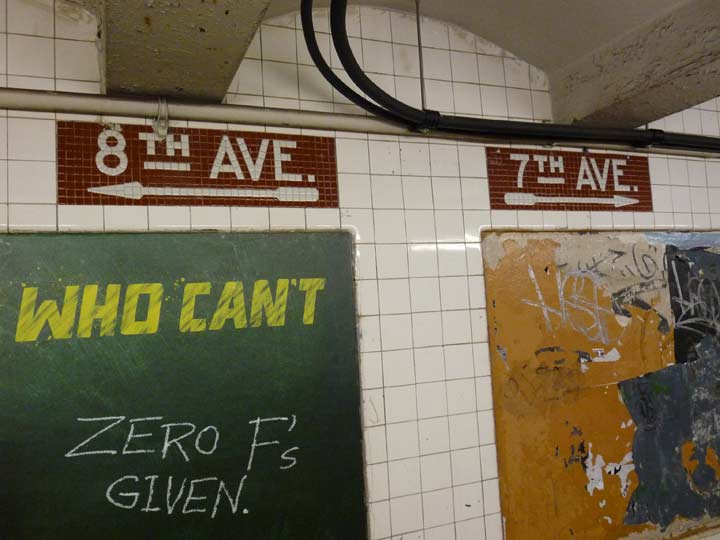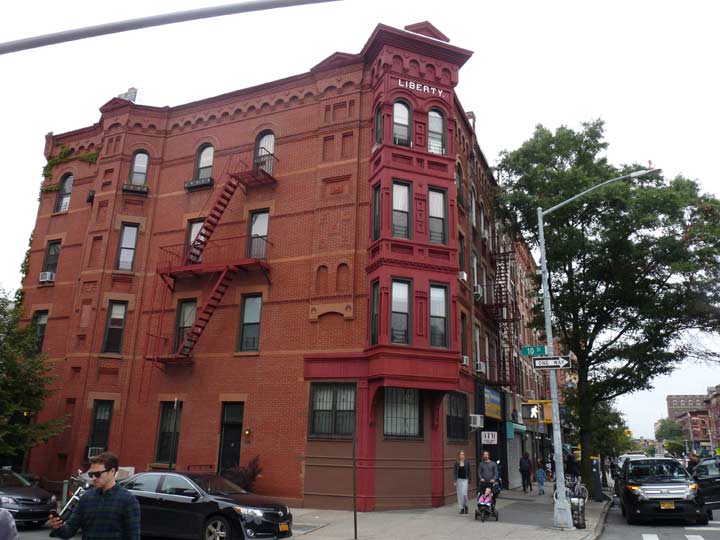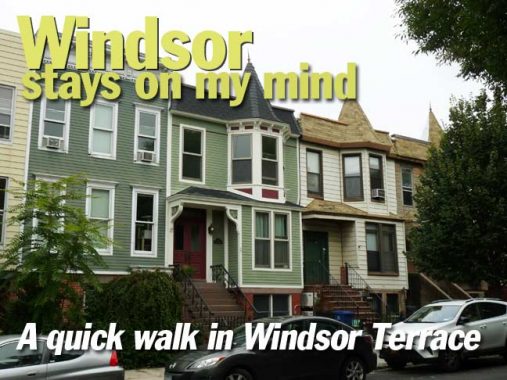I was on my way to a gathering in Caton Park recently when, noticing I had not been able to walk all that much during the week, decided to walk from the IND 7th Avenue station, a route that would take me through Park Slope south of 9th Avenue and then into Windsor Terrace. I’ve been in Windsor Terrace fairly frequently over the 17-plus years of doing Forgotten NY. It was originally the economically friendly alternative to its neighbor Park Slope, but most neighborhoods in Brooklyn have become completely “unaffordable” if you’ve been rent-stabilized for years and have a desire to move elsewhere.

The 7th Avenue IND station takes up an entire underground block along 9th Street between 7th and 8th Avenues and is cavernous. Why IND engineers and architects decided to build their stations so large is a mystery, other than a reaction to the sometimes cramped quarters of the early (1904-1912) Interborough Rapid Transit stations. (Incidentally the newest station in the system, the Hudson Yards station on 11th Avenue, was the first built to IRT specs in decades!)
Here’s a previously undiscovered (by me) pair of tiled directional signs in the center of the concourse.

“The Liberty,” 7th Avenue and 10th Street. Many corner buildings in Park Slope have diagonally-facing corner units that grant occupants a wide view, in this case south on 7th Avenue. NY Daily News columnist Denis Hamill has written often about the Liberty Meat Market formerly a few doors away on 7th Avenue between 10th and 11th Avenues.
Many apartment houses in Park Slope are mini-masterpieces, such as this one at 7th Avenue and 11th Street. The corner on this one has been compromised by metal sheathing and the roof probably once has a crown of some kind, a peak or a dome.
This old school sidewalk sign between 11th and 12th is made of vinyl and plastic lettering. An old-fashioned telephone handset, last sold in quantity in the 1990s, is pictured on the sign.
My admiration for simple brick architecture, especially in factories and factories converted to residential, has been expressed often here and on ForgottenTours, and one of my favorites takes up nearly the entire block between 7th and 8th avenues and 12th and 13th Streets.
The Ansonia Clock Company was founded in Derby, Connecticut in 1851 as a subsidiary of a brass business run by Anson Phelps in the Naugatuck River valley. Ansonia shelf clocks are still very collectible today, with their expert craftsmanship and accurate timekeeping: the firm’s clock cases were made of mahogany, rosewood, and other quality materials. Ansonia moved to Brooklyn in 1879; their original factory there burned down immediately, but the second is still here on 7th Avenue between 12th and 13th Streets.
Active clock production at Ansonia Clocks ended about 1930, whence the machinery was sold off to a Russian manufacturer. In 1981 the factory was divided into apartments and renamed Ansonia Court. The only reminder of the Ansonia days is the sign on Astoria Optical, across the street on 7th Avenue, and some very faded words on the 12th Street side.
[“The Factory”] stopped being a factory in the late ’70s, and bohemian types, musicians and artists, started renting loft space. Then, to everyone’s amazement, The Factory was converted to condos in the ’80s and renamed Ansonia Court. I’d say more than half the guys I hung out with in The Factory are dead now, some lost to street violence, some to drugs, booze, cancer and war.
But last week, as I stood under the big clock of the Williamsburg Bank Building, 40 summers later, I learned they were getting $800,000 for two bedrooms in The Factory, and I just had to close my eyes in the warm July sun and shake my head and laugh. Denis Hamill
I did discover a new wrinkle in the Ansonia on the 12th Street side: a faded painted sign for “Globe Lighting Products Co.” which must have leased space in the Ansonia factory at some time.
I’ve been by here hundreds of times. But I have learned that sometimes, you can’t see anything until you look for it: in this case a pair of exquisite corner street signs, chiseled with care. It must have been a lot tougher to carve e‘s like this, instead of the straight variety. The detail extends to the underscores under the ths and periods at the ends. Books can be written about this stuff.
Compare to the factory-fresh street sign installed by the Department of Transportation, which eliminates the e in the “Ave” abbreviation even though there’s plenty of room, and leaves out the space between the 7 and the Av.
Slapdash stuff, but we come to expect that from the DOT.
SW corner 7th Avenue and 12th Street, a building perhaps built by the same architect as the Liberty two blocks away.
I was a frequent visitor to this building at the SE corner of 7th avenue and 13th Street in the 1980s and 1990s. After a cousin got married, she and her husband had an apartment here for a few years (they have since moved to West Windsor, NJ).
So, I’ve been here a few dozen times. But I never looked to see if it had chiseled corner street signs — it does! There are more prosaically rendered, seemingly with a T-square.
I was intrigued by this row of brickfaced dwellings at 363-365 14th Street just west of 7th Avenue. I enjoy the peaked windows that give them a monasterial look. Unfortunately the buildings are just outside the newly extended Park Slope Historic District as mandated by the Landmarks Preservation Commission, so not much info is available on them.
Shingle signs are the coin of the realm in certain hipper neighborhoods. Unfortunately, because of sign placement, this can lead to occasional misunderstandings…
The sign actually says “Slope Cellars.” The signage is actually quite engaging and features painted glass lettering of the type seen on old-fashioned liquor stores. I do not know if the neon LIQUOR sign is new or old. The store was founded in 2000 and actually has a detailed online history.
I turned at Windsor Place, which begins here at 7th avenue and runs a few blocks south to Prospect Park Southwest, straddling two neighborhoods, Park Slope and Windsor Terrace.
As much as any other neighborhood in Brooklyn, Windsor Terrace’s boundaries are rather easily defined: it’s that narrow strip, about 8 or 9 blocks at the widest, between the vast greenswards of Green-Wood Cemetery and Prospect Park. Prospect Park West (which 9th Avenue is inexplicably called here — the stretch doesn’t border the park) is its northern boundary with Fort Hamilton Parkway the southern.
The neighborhood, named for Windsor, England, was first built up by developer William Bell between 1849 and 1851 between Vanderbilt Street and Greenwood Avenue, and row houses sprang up on 16th Street and Prospect Park Southwest by 1905. Windsor Terrace was heavily Irish in the early 20th Century, and remains a quiet, relatively undiscovered neighborhood despite the construction of the Prospect Expressway from 1953-60; thankfully, a proposal to extend the expressway south along Ocean Parkway — which would have become a 6-lane expressway–was never acted upon.
Originally Windsor Terrace proper extended just from Vanderbilt Street south to Ft. Hamilton Parkway and was a northern extension of the town of Flatbush, but after Flatbush was annexed by Brooklyn in 1894, and Brooklyn was then consolidated with NYC in 1898, just about all the territory “between the green” is included.
Some of the nicer attached brick dwellings on Windsor Place between 7th and 8th Avenues.
There’s a bit of a twist regarding the naming of Windsor Place. Originally, the name was applied to the southern end of 16th Street between Prospect Park West (which actually stands in for 9th Avenue) and Prospect Park Southwest, while today’s Windsor Place was called Braxton Street. Around 1900 the switch was made, with 16th Street retaining the name for its full length and Braxton becoming Windsor Place.
(Why was this done? I have no idea; neither do I know why Harway and Cropsey Avenues in Bath Beach switched identities in the late 1920s, a fact remembered by only me, since I tend to pore over old street atlases in my spare time, which is occasionally more spare than at other times.)
Again between 7th and 8th, this group of buildings has had a layer or two of siding added since they were first built, but the conical roof ornamentations have been retained. The roof treatment on the building at left likely marks it as being of considerable age.
Here’s a grouping of attached brick buildings with alternating oriel window treatments, polygonal and round bays. Both allow occupants to look out of the window in three directions and see most of the block.
Had I not had an appointment I would have likely ducked into Windsor Terrace Antiques and Ephemera at Windsor Place and 10th Avenue. I can usually find decades-old maps and prints to marvel at at these kind of places; I used to be a regular at Pageant Books in the East Village, which dealt in this kind of thing. It opens Thursday through Sunday from 12 to 6 PM.
The Tuscan Gun, 199 Windsor Place just past 10th Avenue, is a Tuscany-themed sandwich shop run by Italian immigrant chef Gabriele Corcos. You may have seen him and his wife, Queens-born actress Debi Mazar, on their Cooking Channel TV show “Extra Virgin.”
Two separate building philosophies face off on Windsor Place between 10th and 11th Avenues: one the south side, conventional attached homes with bay fronts, while opposite there are houses where owners have the option to maintain indoor enclosed porches, or expose their porches in the traditional matter. The variety of windows employed on these homes is engaging.
I’ll finish this abbreviated Windsor Terrace walk with a pair of gnomes at an apartment building entrance at the south end of Windsor terrace at Prospect Park Southwest.
I have much more on Windsor Terrace:
Carroll Gardens to Parkville, Part 2
10/9/16
